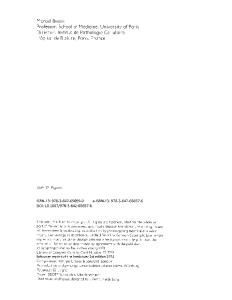Microfluidic Approaches for Biomechanics of Red Blood Cells
Studies of cellular mechanics have led to important advances in our understanding of the physiological processes of human diseases as well as provided adjunct biophysical markers for disease diagnosis and therapeutic evaluations. Microfluidic assays allow
- PDF / 237,466 Bytes
- 5 Pages / 595.276 x 790.866 pts Page_size
- 11 Downloads / 344 Views
Microfluidic Approaches for Biomechanics of Red Blood Cells E. Du
Abstract Studies of cellular mechanics have led to important advances in our understanding of the physiological processes of human diseases as well as provided adjunct biophysical markers for disease diagnosis and therapeutic evaluations. Microfluidic assays allow novel manipulations of single cells quickly and effectively under a physiologically appropriate environment. This paper briefly summarizes our two recently developed microfluidic techniques for probing mechanics of diseased human red blood cells (RBCs). In particular, the in vitro microvascular model allowed characterization of blood micro-rheology in terms of cellular velocity and capillary obstructions under transient hypoxic conditions. These analyses suggested novel mechanics indicators of disease severity and drug treatment in sickle cell anemia. The second microfluidic technique allowed rapid characterization of electrically coupled mechanics of cell membranes from a dielectrophoresisinduced uniaxial stretching of single RBCs. The obtained force-deformation curves agreed well with the independent studies reported in literature for both healthy RBCs and those influenced by Plasmodium falciparum. These findings clearly demonstrated the capabilities of microfluidics in quantitative, mechanical measurements of RBCs and can be potentially applied to other cell types. Keywords Microfluidics • Cellular mechanics • Red blood cell • Sickle cell anemia • Malaria
13.1
Introduction
Normal red blood cells (RBCs) have a biconcave disc shape, about 8 μm in diameter and 2 μm in thickness; they must undergo severe passive deformation while maintaining mechanical stability during circulation, where they are subjected to intensive mechanical stimulation in blood flow or when squeezing through micro capillaries and splenic sinusoids [1]. The remarkable deformability of RBCs largely attributes to the mechanical properties of the membrane, its only structural component. During the repeated passages of several hundred 1000 times in their 120-day normal lifespan, RBCs lose their membrane integrity, become rigid, and are degraded by the mononuclear phagocyte system [2]. Various pathological and physiological conditions can accelerate this process, such as hereditary hemolytic anemias [3], extracorporeal circulation for hemodialysis [4], cardiopulmonary bypass [5], and cold storage of RBC products for transfusion purposes [6, 7]. Many engineering techniques, such as micropipette aspiration [8], atomic force microscopy [9, 10], optical tweezers [11–13], diffraction phase microscopy [14–16], magnetic twisting cytometry [17], have enabled high-precision mechanical measurements of individual cells and cellular components. These studies have demonstrated critical roles of cellular mechanics in various pathophysiological processes and provided novel biophysical markers for disease diagnosis and drug efficacy testing, in malaria [18–20], sickle cell disease [16, 21, 22], and cancer [23–25]. These techniques have
Data Loading...











